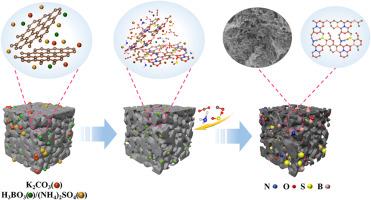Synergistic activation-doping strategy for constructing N/O/B/S Co-doped hierarchical porous carbon from wild jujube pit towards high-performance supercapacitors
IF 5.8
2区 生物学
Q1 AGRICULTURAL ENGINEERING
引用次数: 0
Abstract
This study developed a synergistic activation-doping strategy using Wild Jujube Pits as a carbon source. The K2CO3/(NH4)2SO4/H3BO3 ternary system synchronously modulates pore evolution and heteroatom doping, successfully constructing N/O/B/S-co-doped hierarchical porous carbon (JS1211). Characterisation results demonstrate that JS1211 possesses a high SSA of 1496 m2 g−1 with hierarchical porosity (micropores: 0.4–0.8 nm; mesopores: 2–10 nm). XPS analysis confirms uniform co-doping of N (7.55 at%), B (6.04 at%), S (0.56 at%), and O (15.78 at%), where pyridinic-N (49.4 %) and BC2O (43.6 %) configurations dominate. DFT calculations reveal a three-tiered doping mechanism proceeding through structural distortion → electronic reconstruction → property optimisation. Electrochemical testing shows JS1211 delivers a specific capacitance of 411 F g−1 at 0.5 A g−1, with 81.75 % capacity retention at 20 A g−1 and 97.31 % capacitance retention after 5000 cycles (Coulombic efficiency: 100.46 %). The assembled symmetric supercapacitor achieves an energy density of 12.85 Wh kg−1 (Power density: 129.71 W kg−1) in a 6 M KOH electrolyte, while retaining 7.85 Wh kg−1 at a power density of 10,335 W kg−1. This work provides new insights for developing biomass-derived high-performance supercapacitor electrodes.

利用野枣核构建N/O/B/S共掺杂层次化多孔碳制备高性能超级电容器的协同活化掺杂策略
本研究以野生枣核为碳源,开发了一种协同活化掺杂策略。K2CO3/(NH4)2SO4/H3BO3三元体系同步调控孔隙演化和杂原子掺杂,成功构建了N/O/B/ s共掺杂的分级多孔碳(JS1211)。表征结果表明,JS1211具有1496 m2 g−1的高SSA,具有分层孔隙度(微孔:0.4-0.8 nm,介孔:2-10 nm)。XPS分析证实了N (7.55 at%)、B (6.04 at%)、S (0.56 at%)和O (15.78 at%)的均匀共掺杂,其中吡啶-N(49.4%)和BC2O(43.6%)占主导地位。DFT计算揭示了结构畸变→电子重构→性能优化的三层掺杂机制。电化学测试表明,JS1211在0.5 a g−1时的比电容为411 F g−1,在20 a g−1时的容量保持率为81.75%,在5000次循环后的电容保持率为97.31%(库仑效率为100.46%)。所制备的对称超级电容器在6 M KOH电解液中能量密度为12.85 Wh kg−1(功率密度为129.71 W kg−1),在功率密度为10,335 W kg−1时能量密度为7.85 Wh kg−1。这项工作为开发生物质衍生的高性能超级电容器电极提供了新的见解。
本文章由计算机程序翻译,如有差异,请以英文原文为准。
求助全文
约1分钟内获得全文
求助全文
来源期刊

Biomass & Bioenergy
工程技术-能源与燃料
CiteScore
11.50
自引率
3.30%
发文量
258
审稿时长
60 days
期刊介绍:
Biomass & Bioenergy is an international journal publishing original research papers and short communications, review articles and case studies on biological resources, chemical and biological processes, and biomass products for new renewable sources of energy and materials.
The scope of the journal extends to the environmental, management and economic aspects of biomass and bioenergy.
Key areas covered by the journal:
• Biomass: sources, energy crop production processes, genetic improvements, composition. Please note that research on these biomass subjects must be linked directly to bioenergy generation.
• Biological Residues: residues/rests from agricultural production, forestry and plantations (palm, sugar etc), processing industries, and municipal sources (MSW). Papers on the use of biomass residues through innovative processes/technological novelty and/or consideration of feedstock/system sustainability (or unsustainability) are welcomed. However waste treatment processes and pollution control or mitigation which are only tangentially related to bioenergy are not in the scope of the journal, as they are more suited to publications in the environmental arena. Papers that describe conventional waste streams (ie well described in existing literature) that do not empirically address ''new'' added value from the process are not suitable for submission to the journal.
• Bioenergy Processes: fermentations, thermochemical conversions, liquid and gaseous fuels, and petrochemical substitutes
• Bioenergy Utilization: direct combustion, gasification, electricity production, chemical processes, and by-product remediation
• Biomass and the Environment: carbon cycle, the net energy efficiency of bioenergy systems, assessment of sustainability, and biodiversity issues.
 求助内容:
求助内容: 应助结果提醒方式:
应助结果提醒方式:


